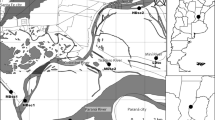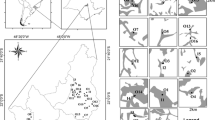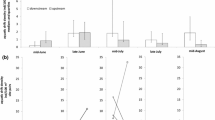Abstract
Significant quantities of woody debris are found in stream channels draining forested watersheds. For example, as much as 250–800 tons/hectare of woody debris were found in stream channels of old growth conifer forests compared to 40–130t/ha in streams draining mixed hardwood forests (Triska and Cromack 1980). Once in a stream, woody debris has a much longer residence time than leaves due to its slow rate of decomposition and its large size which resists displacement (Swanson et al. 1976). In stream systems, woody debris influences channel morphology, increases habitat diversity, affects transport of other materials by forming debris dams and serves as a carbon source, site of attachment and shelter for aquatic organisms (Fisher and Likens 1972; Anderson and Sedell 1979; Bilby and Likens 1980; Bird and Kaushik 1981; Harmon et al. 1986).
Access this chapter
Tax calculation will be finalised at checkout
Purchases are for personal use only
Preview
Unable to display preview. Download preview PDF.
Similar content being viewed by others
References
Abdullah SK, Descals E, Webster J (1981) Teleomorphs of three aquatic hyphomycetes. Trans Br Mycol Soc 77: 475–483
Anderson NH, Sedell JR (1979) Detritus processing by macroinvertebrates in stream ecosystems. Annu Rev Entomol 24: 351–377
Anderson NH, Sedell JR, Roberts LM, Triska FJ (1978) The role of aquatic invertebrates in processing of wood debris in coniferous forest streams. Am Midl Nat 100: 64–82
Archer J, Willoughby LG (1969) Wood as a growth substratum for a freshwater foam spore. Trans Br Mycol Soc 53: 484–487
Arnold GRW (1970) De Specie nova generis Ingoldia. Nov Syst Plant non Vasc 6:173–176
Aumen NG, Bottomly PJ, Ward GM, Gregory SV (1983) Microbial decomposition of wood in streams: distribution of microflora and factors affecting [14C]lignocellulose mineralization. Appl Environ Microbiol 46: 1409–1416
Bärlocher F (1985) The role of fungi in the nutrition of stream invertebrates. Bot J Linn Soc 91: 83–94
Bärlocher F (1991) Intraspecific hyphal interactions among aquatic hyphomycetes. Mycologia 83: 82–88
Bärlocher F, Oertli JJ (1978) Inhibitors of aquatic hyphomycetes in dead conifer needles. Mycologia 70: 964–974
Bärlocher F, Schweizer M (1983) Effects of leaf size and decay rate on colonization by aquatic hyphomycetes. Oikos 41: 205–210
Bärlocher F, Kendrick B, Michaelides J (1978) Colonization and conditioning of Pinusresinosa needles by aquatic hyphomycetes. Arch Hydrobiol 81: 462–474
Benner R, Moran MA, Hodson RE (1986) Biogeochemical cycling of lignocellulosic carbon in marine and freshwater ecosystems: relative contributions of prokaryotes and eukaryotes Limnol Oceanogr 31: 89–100
Bilby RE, Likens GE (1980) Importance of organic debris dams in the structure and function of stream ecosystems. Ecology 61: 1107–1113
Bird GA, Kaushik NK (1981) Coarse particulate organic matter in streams. In: Lock MA, Williams DD (eds) Perspectives in running water ecology. Plenum, New York, pp 41–68
Browning BL (1963) The composition and chemical reactions of wood. In: Browning BL (ed) The chemistry of wood. Interscience Publ, John Wiley and Sons, New York, pp 57–102
Butler SK, Suberkropp K (1986) Aquatic hyphomycetes on oak leaves: comparison of growth, degradation and palatability. Mycologia 78: 922–928
Charnier AC (1985) Cell-wall degrading enzymes of aquatic hyphomycetes: a review. Bot J Linn Soc 91: 67–81
Chamier AC, Dixon PA (1982) Pectinases in leaf degradation by aquatic hyphomycetes: the enzymes and leaf maceration. J Gen Microbiol 128: 2469–2483
Cooke RC, Rayner ADM (1984) Ecology of saprotrophic fungi. Longman, New York
Crane JL, Dumont KP (1975) Hyphomycetes from the West Indies and Venezuela. Can J Bot 53: 843–851
Danninger E, Messner K, Rohr M (1979) Untersuchungen über den biologischen Abbau organischer Naturstoffe durch aquatische Hyphomyzeten. Zentralbl Bakteriol Hyg I Abt Orig B 169: 282
Descals E, Sutton BC (1976) Anavirga dendromorphaand its Phialocephala phialidic state. Trans Br Mycol Soc 67:269–274
Descals E, Webster J (1982) Taxonomic studies on aquatic hyphomycetes III. Some new species and a new combination. Trans Br Mycol Soc 78: 405–437
Descals E, Fisher PJ, Webster J (1984) The Hymenoscyphus teleomorph of Geniculospora grandis. Trans Br Mycol Soc 83: 541–546
Dudley T, Anderson NH (1982) A survey of invertebrates associated with wood debris in aquatic habitats. Melanderia 39: 1–21
Eaton RA, Jones EBG (1971) The biodeterioration of timber in water cooling towers. II. Fungi growing on wood in different positions in water cooling towers. Mater Org 6: 81–92
Findlay WPK (ed) (1985) Preservation of timber in the tropics. Dr. W Junk Publishers, Dordrecht, The Netherlands
Fisher PJ, Davey RA, Webster J (1983) Degradation of lignin by aquatic and aero-aquatic hyphomycetes. Trans Br Mycol Soc 80: 166–168
Fisher SG, Likens GE (1972) Stream ecosystem: organic energy budget. BioScience 22: 33–35
Gunasekera SA, Webster J (1983) Effect of nitrate and phosphate on weight losses of pine and oak wood caused by aquatic and aero-aquatic hyphomycetes. Trans Br Mycol Soc 80: 507–514
Hamad SR, Webster J (1987) Anavirga dendromorpha, anamorph of Apostemidium torrenticola. Sydowia 40:60–64
Harmon ME, Franklin JF, Swanson FJ, Sollins P, Gregory SV, Lattin JD, Anderson NH, Cline SP, Aumen NG, Sedell JR, Lienkaemper GW, Cromack K JR, Cummins KW (1986) Ecology of coarse woody debris in temperate ecosystems. Rec Adv Ecol Res 15: 133–302
Ingold CT (1952) Actinospora megalospora n. sp., an aquatic hyphomycete. Trans Br Mycol Soc 35:66–70
Iqbal SH (1971) New aquatic hyphomycetes. Trans Br Mycol Soc 56:343–352 Iqbal SH (1974) New aquatic hyphomycetes. Biologia 20: 1–10
Iqbal SH, Bhatty SF (1980) New freshwater hyphomycetes from Pakistan. Trans Mycol Soc Jpn 21: 71–75
Jones EBG (1972) The decay of timber in aquatic environments. Br Wood Presery Assoc Annu Cony, pp 1–18
Jones EBG (1981) Observation on the ecology of lignicolous aquatic hyphomycetes. In: Wicklow DT, Carroll GC (eds) The fungal community: its organization and role in the ecosystem. Marcel Dekker, New York, pp 731–742
Jones EBG, Oliver AC (1964) Occurrence of aquatic hyphomycetes on wood submerged in fresh and brackish water. Trans Br Mycol Soc 47: 45–48
Jones EBG, Stewart RJ (1972) Tricladium varium, an aquatic hyphomycete on wood in water-cooling towers. Trans Br Mycol Soc 59:163–167
Kane D (1980) The effect of sewage effluent on the growth of micro-organisms in the marine environment. PhD Thesis, Portsmouth Polytechnic, Portsmouth, England Kirk PW (1969) Aquatic hyphomycetes on wood in an estuary. Mycologia 61: 177–181
Kirk TK (1983) Degradation and conversion of lignocellulose. In: Smith JF, Berry DR,Kristansen B (eds) The filamentous fungi. Edward Arnold, London, pp 266–295
Kirk TK, Cowling EB (1984) Biological decomposition of solid wood. Am Chem Soc Ser 207: 457–487
Lamore BJ, Goos RD (1978) Wood-inhabiting fungi of a freshwater stream in Rhode Island. Mycologia 70: 1025–1034
Melillo JM, Naiman RJ, Aber JD, Eshleman KN (1983) The influence of substrate quality and stream size on wood decomposition dynamics. Oecologia 58: 281–285
Nawawi A (1974) A new Campylospora. Trans Br Mycol Soc 63: 603–607
Nawawi A (1975) Triscelophorus acuminatus sp. nov. Trans Br Mycol Soc 64:345–348
Nawawi A (1976) A new genus of Hyphomycetes. Trans Br Mycol Soc 66: 344–347
Nawawi A, Kuthubutheen AJ (1988) Additions to Condylospora ( Hyphomycetes) from Malaysia. Mycotaxon 33: 329–338
Nawawi A, Kuthubutheen AJ (1989) Quadricladium aquaticum Gen et sp. nov., an aquatic hyphomycete with tetraradiate conidia. Mycotaxon 34:489–495
Nilsen HC, Larimore RW (1973) Establishment of invertebrate communities on log substrates in the Kaskaskia River, Illinois. Ecology 54: 366–374
Nilsson S (1964) Freshwater hyphomycetes: taxonomy, morphology and ecology. Symb Bot Ups 18: 1–130
Pereira CRD, Anderson NH, Dudley T (1982) Gut content analysis of aquatic insects from wood substrates. Melanderia 39: 23–33
Perrott E (1960) Ankistrocladium fuscum Gen nov., sp. nov., an aquatic hyphomycete. Trans Br Mycol Soc 43:556–558
Petersen RH (1960) Culicidospora,a new genus of aquatic, aleuriosporous hyphomycetes. Bull Torrey Bot Club 87:342–347
Pettersen RC (1984) The chemical composition of wood. In: Rowell RM (ed) The chemistry of solid wood. Advances in chemistry series 207. American Chemical Society, Washington, DC, pp 57–126
Price IP, Talbot PHB (1966) An aquatic hyphomycete in a lignicolous habitat. Aust J Bot 14: 19–23
Pugh GFJ (1980) Strategies in fungal ecology. Trans Br Mycol Soc 75: 1–14
Ranzoni FV (1951) Nutrient requirements for two species of aquatic hyphomycetes. Mycologia 43: 130–141
Ranzoni FV (1953) The aquatic hyphomycetes of California. Farlowia 4: 353–398
Ranzoni FV (1956) The perfect stage of Flagellospora penicillioides. Am J Bot 43: 13–17
Rayner ADM, Boddy L (1988) Fungal decomposition of wood. Its biology and ecology. John Wiley & Sons, New York
Rayner ADM, Todd NK (1979) Population and community structure and dynamics of fungi in decaying wood. Adv Bot Res 7: 333–420
Révay A, Gönczöl J (1990) Longitudinal distribution and colonization patterns of woodinhabiting fungi in a mountain stream in Hungary. Nova Hedwigia 51: 505–520
Sanders PF, Anderson JM (1979) Colonization of wood blocks by aquatic hyphomycetes. Trans Br Mycol Soc 73: 103–107
Scheffer TC, Cowling EB (1966) Natural resistance of wood to microbial deterioration. Annu Rev Phytopathol 4: 147–170
Shearer CA (1972) Fungi of the Chesapeake Bay and its tributaries. III. The distribution of wood-inhabiting ascomycetes and fungi imperfecti of the Patuxent River. Am J Bot 59: 961–969
Shearer CA (1989a) Aniptodera (Halosphaeriaceae) from wood in freshwater habitats. Mycologia 81:139–146
Shearer CA (1989b) Pseudohalonectria (Lasiosphaeriaceae), an antagonistic genus from wood in freshwater. Can J Bot 81:139–146
Shearer CA, Bartolata M (1990) Experimental determination of in situ competitive interactions among aquatic lignicolous fungi. In: Reisinger A, Bresinsky A (eds) Abstr 4th Int Mycol Congr, Regensburg, Germany. Botanical Institute, Univ Regensburg
Shearer CA, Crane JL (1978) The distribution of Nais inornata, a facultative marine ascomycete. Mycotaxon 7: 443–452
Shearer CA, Crane JL (1985) Aquadiscula appendiculata, a new genus and species of Discomycetes from leaves submerged in a freshwater swamp. Mycologia 77:441–446
Shearer CA, Crane JL (1986) Illinois fungi. XII. Fungi and myxomycetes from wood and leaves submerged in southern Illinois swamps. Mycotaxon 25: 527–538
Shearer CA, von Bodman S (1983) Patterns of occurrence of ascomycetes associated with decomposing twigs in a mid-western stream. Mycologia 75: 518–530
Shearer CA, Webster J (1991) Aquatic hyphomycetes in the River Teign IV. Twig colonization. Mycol Res 95: 413–420
Shearer CA, Zare-Maivan H (1988) In vitro hyphal interactions among wood-and leaf-inhabiting Ascomycetes and Fungi Imperfecti from freshwater habitats. Mycologia 80: 31–37
Sinclair RC, Morgan-Jones G (1979) Notes on hyphomycetes. XXXII. Five new aquatic species. Mycotaxon 9: 469–481
Slâdeckovâ A (1963) Aquatic deuteromycetes as indicators of starch campaign pollution. Int Rev Ges Hydrobiol 48: 35–42
Suberkropp K, Klug MJ (1980) The maceration of deciduous leaf litter by aquatic hyphomycetes. Can J Bot 58: 1025–1031
Suberkropp K, Klug MJ (1981) The degradation of leaf litter by aquatic hyphomycetes. In: Wicklow DT, Carroll GC (eds) The fungal community. Marcel Dekker, New York
Suberkropp K, Arsuffi TL, Anderson JP (1983) Comparison of degradative ability, enzymatic activity, and palatability of aquatic hyphomycetes grown on leaf litter. Appl Enviton Microbiol 46: 237–244
Swanson FJ, Lienkeamper GW, Sedell JR (1976) History, physical effects and management implications of large organic debris in western Oregon streams. USDA For Sery Gen Tech Rep PNW-56, Washington, DC
Swift MJ (1977) The ecology of wood decomposition. Sci Prog (Oxford) 64:175–199 Thornton DR (1963) The physiology and nutrition of some aquatic hyphomycetes. J Gen Microbiol 33: 23–31
Triska FJ, Cromack K (1980) The role of wood debris in forests and streams. In: Waring RH (ed) Forests: fresh perspectives from ecosystem analysis. Proc 40th Biology Colloq, 1979, Oregon State University Press, Corvallis
Tubaki K (1958) Studies of the Japanese hyphomycetes V. Leaf and stem group with a discussion of the classification of hyphomycetes and their perfect stages. J Hattori Bot Lab 20: 142–244
Tubaki K (1966) An undescribed species of Hymenoscyphus, a perfect stage of Varicosporium. Trans Br Mycol Soc 49: 345–349
Webber JF, Hedger JN (1986) Comparisons of interactions between Ceratocystis ulmi and elm bark saprobes in vitro and in vivo. Trans Br Mycol Soc 86: 93–101
Webster J (1959) Nectria lugdunensis sp. nov., the perfect state of Heliscus lugdunensis. Trans Br Mycol Soc 42:322–327
Webster J, Descals E (1981) Morphology, distribution, and ecology of conidial fungi in freshwater habitats. In: Cole GC, Kendrick B (eds), Biology of conidial fungi, vol 1. Academic Press, New York
Wicklow DT (1981) Interference competition and the organization of fungal communities. In: Wicklow DT, Carroll GC (eds) The fungal community, its organization and role in the ecosystem. Marcel Dekker, New York, pp 351–375
Willoughby GL, Archer JF (1973) The fungal spora of a freshwater stream and its colonization on wood. Freshwater Biol 3: 219–239
Zare-Maivan H, Shearer CA (1988a) Extracellular enzyme production and cell wall degradation by freshwater lignicolous fungi. Mycologia 80: 365–375
Zare-Maivan H, Shearer CA (1988b) Wood decay activity and cellulase production by freshwater lignicolous fungi. Int Biodeterior Bull 24: 459–474
Zemek J, Marvanova L, Kuniak L, Kadlecikova B (1985) Hydrolytic enzymes in aquatic hyphomycetes. Folia Microbiol 30: 363–372
Editor information
Editors and Affiliations
Rights and permissions
Copyright information
© 1992 Springer-Verlag Berlin Heidelberg
About this chapter
Cite this chapter
Shearer, C.A. (1992). The Role of Woody Debris. In: Bärlocher, F. (eds) The Ecology of Aquatic Hyphomycetes. Ecological Studies, vol 94. Springer, Berlin, Heidelberg. https://doi.org/10.1007/978-3-642-76855-2_4
Download citation
DOI: https://doi.org/10.1007/978-3-642-76855-2_4
Publisher Name: Springer, Berlin, Heidelberg
Print ISBN: 978-3-642-76857-6
Online ISBN: 978-3-642-76855-2
eBook Packages: Springer Book Archive




